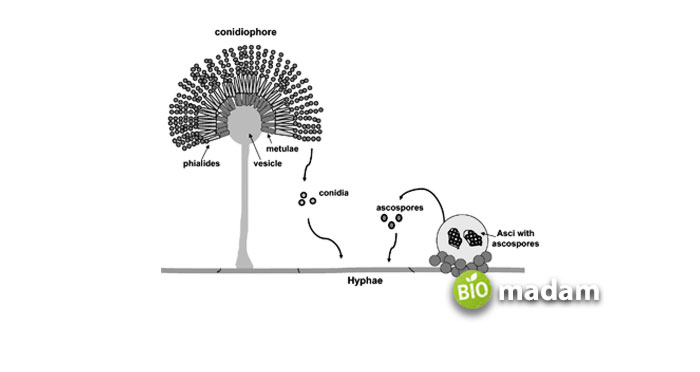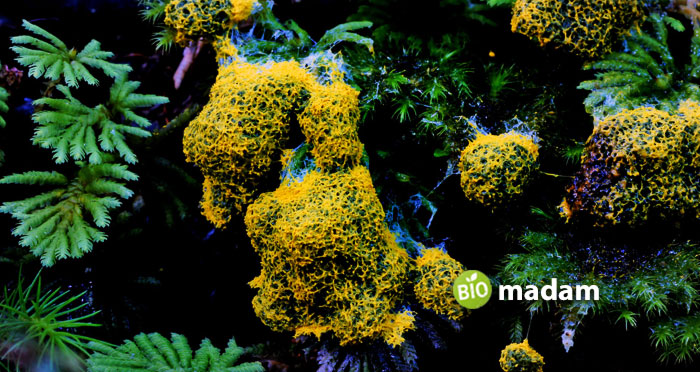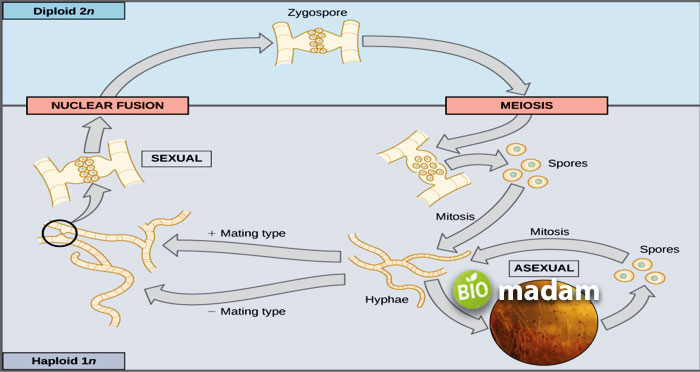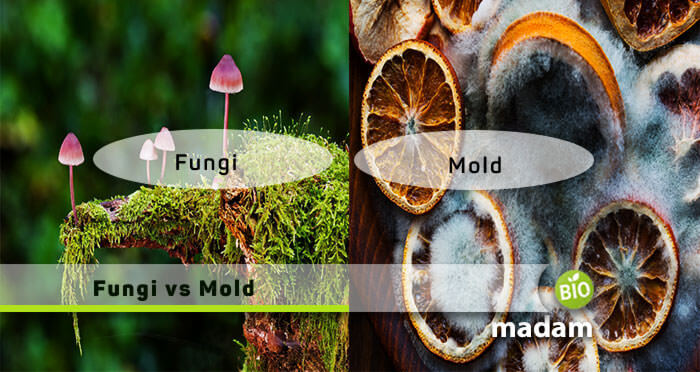Recently updated on October 5th, 2023 at 09:25 am
We often have heard the words fungi and molds used interchangeably, which causes serious problems when attacking several home corners. If you have been using these terms for a single purpose till now, know that fungi and molds are entirely different with different nature, appearance, advantages, and characteristics.
Fungi were previously classified as plants, but are now recognized as separate. These can be unicellular or multicellular organisms with a unique cell wall called chitin. On the other hand, a mold is always a multicellular entity. Both of them are from the Kingdom Fungi. Let’s move further to know their differences in detail.
Comparison Chart
| Parameters | Fungi | Mold |
|---|---|---|
| Introduction | An entire kingdom | Type of fungus |
| Cellular Nature | Can be unicellular or multicellular | Multicellular organism |
| Spores | Multiple asexual spores; yeast | Asexual spores; conidia |
| Used In | Alcohol production & baking | Antibiotics preparation |
| Types | 200,000 plus | 100,000 plus |
| Edible | Some are edible | Non-edible |
| Habitat | Grown anywhere | Mostly in damp areas |
| Aerobic/Anaerobic | Can be aerobic or anaerobic | Aerobic organisms |
What are Fungi?
These are entirely different kingdoms, comprising unicellular or multicellular organisms that are heterotrophs. A heterotrophic organism cannot prepare its food. There are almost 44,000 known fungi species from different genera, some of which are yeasts, rusts, smuts, mildews, molds, and mushrooms.

Know its Characteristics
We have explained the characteristics of Fungi below for you to understand them easily:
- Fungi are invisible to the naked eye. Occasionally, a few fungi will give rise to large ‘fruiting bodies’ known as mushrooms that bring about a significant number of spores for reproduction.
- They are unicellular as well as multicellular organisms.
- Furthermore, its cell wall contains protoplast, which is further characterized by other parts, e.g., cell membrane, cytoplasm, and nuclei.
- The fungal nucleus is rigid and translucent with numerous fine chromatin threads. Moreover, it is encased by a nuclear membrane.
- Mycology, the study of fungi, is a critical field of biology because fungi are essential for many ecological and economic causes.
Structure
Some fungi possess structures similar to the plasmids (DNA strands). Different organelles, such as mitochondria and complex internal membranes comprising the ER and Golgi apparatus, are present in fungal cells. A significant portion of a fungal body is built from a framework of long, slender filaments known as ‘hyphae.’ Hyphae filaments are composed of tubular cells that join end on end. Fungal cell walls are dense with complex polysaccharides inside, known as chitin and glucans.
Habitat
They can survive in every habitat, in almost every Earth part, but are most abundant on land, in water, air, and mostly in plants and animals.
Types
Fungi are generally classified into four types:
- Chytridiomycota (chytrids)
- Zygomycota (bread molds)
- Ascomycota (yeasts)
- Basidiomycota (club fungi)
Reproduction

These organisms can reproduce sexually as well as asexually. Perfect fungi usually produce both ways, but imperfect fungi can only grow by asexual reproduction (mitosis). In both types, fungi give rise to spores that separate from the parent in two ways: wind or riding on an animal. Moreover, fungal spores are tiny and lighter than plant seeds, but they are still not quickly released as high in the air. The massive puffball mushroom rupture and discharges millions of spores.
Asexual reproduction takes place by binary fission, fragmentation, budding, or spore formation.
Sexual reproduction initiates genetic variation in a population of fungi. In fungi, unfavorable environmental conditions lead to sexual reproduction.
Fungi are responsible for the production of two mating types:
- If both mating types are present in a single mycelium, it is known as homothallic mycelium or self-fertile.
- On the other hand, in heterothallic mycelia, two non-identical but harmonious mycelia are needed to reproduce sexually.
Nutrition
Fungi obtain their food by consuming diverse organic compounds from the environment. Like animals, they cannot prepare their food; instead, they utilize complex organic compounds as a carbon reservoir. A fungus gets nutrients in two ways:
- Few fungi are saprobes, which gain nutrients from dead and decompose organic matter.
- Some parasitic fungi live in or on other organisms and acquire their desired nutrients from the respective host.
What are Molds?
Mold is a familiar type of fungus which contains many nuclei. It is thread-like fungi made up of hyphae, the multicellular filaments. Different mold colonies are easily visible to the naked eye. If we briefly talk about its habitat, they grow in dark and damp areas. Molds exist in various colors, including black, pink, brown, green, purple, and orange.

Know its Characteristics
Following are the primary characteristics of a mold:
- The body of mold is known as thallus that is composed of hyphae. These structures are columnar, branching tubular sections, lengthening by growth at the upper end.
- Furthermore, a mold’s diameter is approximately 2-10 µm which is sub-divided into units by cross-walls referred to as septa.
- A pile of hyphae called mycelium is responsible for the thread-like nature of the mold.
- Photosynthesis is not the primary source to receive energy in molds.
Habitat
These tiny organisms are found almost anywhere around us, and it’s easy to figure them out because of their larger size. Molds flourish in a damp environment.
Nutrition
The part of the mycelium that fixes the mold and obtains nutrients is known as the vegetative mycelium. They must acquire their food from other organic sources as they cannot “eat” their food. In other words, molds must take in nutrients from other organisms.
So, for this purpose, molds divide the more significant food substances into tiny organic molecules with the help of enzymes released by mycelia. In addition, molds play a vital role in material biodegradation by dead and decaying organic matter.
Reproduction

These organisms can quickly grow through sexual or asexual reproduction. They give rise to many tiny spores, which may be uninucleate (having one nucleus) or multinucleate. Spores of mold can be asexual (the output of mitosis) or sexual (the products of meiosis), but the majority of the species can produce both types.
The part of the mold capable of producing asexual reproductive spores is the aerial mycelium. Following are some sexual spores:
- Zygospores
- Ascospores
- Basidiospores
Similarly, different asexual spores are:
- Sporangiospores
- Conidia
These spores are nano-sized cells discharged in the air. They act just like seeds and develop the mold community.
Quote Some Examples of Molds
Here are a few species of mold that scientists over time have discovered:
- Rhizopus
- Basidiobolus
- Trichophyton
- Penicillium
- Aspergillus
Grasp the Detailed Differences between Fungi and Mold
Brief Description
Fungi
A fungus is a unicellular/multicellular organism having a chitinous cell wall.
Molds
A mold is a massive group of multicellular thread-like fungi usually present in moist and damp areas.
Types
Fungi
These organisms are thought to have over two hundred thousand species. The diversity in types of fungi is due to its ability to hold numerous characteristics of different species and subspecies.
Molds
In contrast, molds have over a hundred thousand species, classified into toxigenic, allergenic, and pathogenic units.
Variation in Colony
Fungi
There is a wide variety of colors in fungi that are very smooth, for example, pink, green, brown, white, etc.
Molds
Similarly, molds are also very colorful and usually observed as purple, orange, black, green, and brown.
Spore Formation
Fungi
Fungi bring about numerous types of asexual spores.
Molds
On the contrary side, molds produce asexual spores called conidia.
Growth
Fungi
The fungus can grow in aerobic as well as the anaerobic environment. It wouldn’t be wrong to say that all fungi can quickly grow anywhere on the Earth.
Molds
On the other hand, molds require damp or dark areas and particular aerobic conditions for their growth.
Developmental Stages
Fungi
A fungus usually lives as three different organisms: giant mushroom and a fruiting body, unicellular organisms, and multicellular molds (with a complex organization of hyphae).
Molds
In contrast, molds begin their development as a single spore, known as a “mold spore.”
Advantages
Fungi
Fungi are commonly utilized in ethanol production and baking.
Molds
The advanced studies made it possible, and now we can use molds to produce different antibiotics for human welfare. But these antibiotics are sometimes seen to cause constipation.
Harmful Effects
Fungi
Some fungi can throw harmful effects on human health in lung diseases, defective immune systems, and candidiasis.
Molds
Similarly, molds can also badly influence human life; for example, they can result in allergies and severe respiratory problems.
Final Verdict
As discussed earlier, both the species fall under the same Kingdom and possess a few similar features but are entirely different. Fungi can be in the form of yeast, mushrooms, and molds, but a mold can never be a fungus. We can conclude the differences between fungi and molds by stating that both have structural variations.

Anna has completed her degree in Pharmacy from the University of Hawaii. She is serving as a research assistant in a pharmaceutical company. She had a great interest in writing blogs, traveling to different parts of the US, and trying delicious recipes in her spare time.

